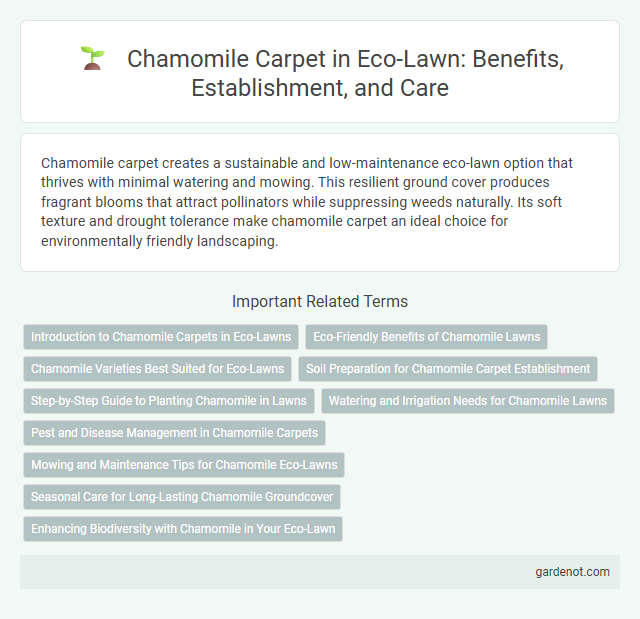Chamomile carpet creates a sustainable and low-maintenance eco-lawn option that thrives with minimal watering and mowing. This resilient ground cover produces fragrant blooms that attract pollinators while suppressing weeds naturally. Its soft texture and drought tolerance make chamomile carpet an ideal choice for environmentally friendly landscaping.
Introduction to Chamomile Carpets in Eco-Lawns
Chamomile carpets offer an eco-friendly alternative to traditional grass lawns by providing a dense, low-maintenance ground cover that supports biodiversity and reduces water usage. These carpets thrive in various climates, producing fragrant yellow and white flowers that attract pollinators while suppressing weeds naturally. Incorporating chamomile carpets into eco-lawns enhances soil health, promotes native ecosystems, and contributes to sustainable landscaping practices.
Eco-Friendly Benefits of Chamomile Lawns
Chamomile lawns offer significant eco-friendly benefits by requiring minimal water and fertilizer, which reduces environmental impact and conserves natural resources. Their natural pest-repellent properties eliminate the need for chemical pesticides, promoting healthier soil and biodiversity. Chamomile also improves soil quality and prevents erosion with its dense, low-growing carpet, enhancing sustainability in landscaping.
Chamomile Varieties Best Suited for Eco-Lawns
Chamomile carpet varieties such as Roman chamomile (Chamaemelum nobile) and German chamomile (Matricaria chamomilla) excel in eco-lawns due to their low growth habit, soft texture, and natural resistance to pests. Roman chamomile thrives in well-drained soils and tolerates light foot traffic, making it ideal for sustainable lawn alternatives that require minimal maintenance. These chamomile species contribute to biodiversity by attracting pollinators while providing a fragrant, drought-tolerant ground cover perfect for eco-conscious landscaping.
Soil Preparation for Chamomile Carpet Establishment
Effective soil preparation for chamomile carpet establishment involves deep tilling to a depth of 6-8 inches to enhance aeration and root penetration. Soil pH should be adjusted to a slightly acidic to neutral range of 6.0-7.0, ensuring optimal nutrient availability for chamomile growth. Incorporating organic matter such as compost improves soil structure and moisture retention, promoting a healthy chamomile lawn.
Step-by-Step Guide to Planting Chamomile in Lawns
Planting chamomile in lawns requires preparing well-drained soil with a pH of 5.6 to 7.5, followed by scattering seeds evenly in early spring or fall to ensure optimal germination. Maintain consistent moisture without overwatering, and lightly press seeds into the soil surface to promote root establishment. Regular mowing at a height of 1 to 2 inches encourages dense, low-growing chamomile carpets that enhance lawn aesthetics and provide natural pest repellence.
Watering and Irrigation Needs for Chamomile Lawns
Chamomile lawns thrive with moderate watering, requiring about 1 inch of water per week to maintain healthy growth while avoiding overwatering. Irrigation should be deep and infrequent, allowing the soil to dry slightly between waterings to promote strong root development and drought resistance. Efficient drip irrigation systems and morning watering schedules reduce water waste and prevent fungal diseases common in chamomile carpets.
Pest and Disease Management in Chamomile Carpets
Effective pest and disease management in chamomile carpets involves regular monitoring for common pests such as aphids, spider mites, and whiteflies, which can cause significant leaf damage. Employing integrated pest management (IPM) strategies, including the use of natural predators, organic insecticides, and maintaining proper soil health, helps reduce infestations and prevent fungal diseases like powdery mildew. Proper watering practices and adequate spacing promote air circulation, minimizing the risk of disease development and ensuring a healthy, thriving chamomile carpet.
Mowing and Maintenance Tips for Chamomile Eco-Lawns
Chamomile eco-lawns thrive with minimal mowing, best maintained at a height of 2-3 inches to promote dense growth and prevent flowering from taking over. Regular, gentle trimming encourages a lush, carpet-like appearance while reducing weed intrusion and enhancing the lawn's natural fragrance. Watering should be moderate, ensuring soil remains moist but not waterlogged to support healthy chamomile roots and vibrant green foliage.
Seasonal Care for Long-Lasting Chamomile Groundcover
Maintaining a Chamomile carpet for eco-lawn benefits requires regular seasonal care including light watering during dry periods to ensure deep root hydration and promote lush growth. Pruning the groundcover after flowering prevents overgrowth, encourages new shoots, and sustains the dense, fragrant coverage that characterizes healthy Chamomile lawns. Applying organic mulch in early spring conserves soil moisture, controls weeds, and enriches soil nutrients, supporting a resilient and long-lasting Chamomile groundcover.
Enhancing Biodiversity with Chamomile in Your Eco-Lawn
Chamomile carpet in eco-lawns supports enhancing biodiversity by providing habitat and nectar for pollinators such as bees and butterflies. Its low-maintenance nature and natural pest-repellent properties reduce the need for chemical treatments, promoting a healthier ecosystem. Incorporating chamomile helps improve soil health and encourages beneficial insects, contributing to a balanced and sustainable lawn environment.
Chamomile carpet Infographic

 gardenot.com
gardenot.com